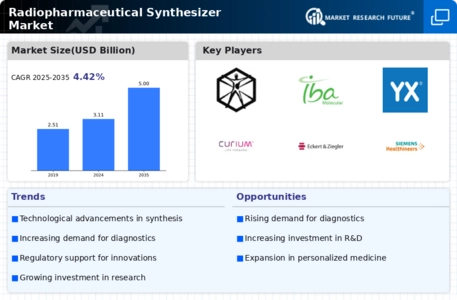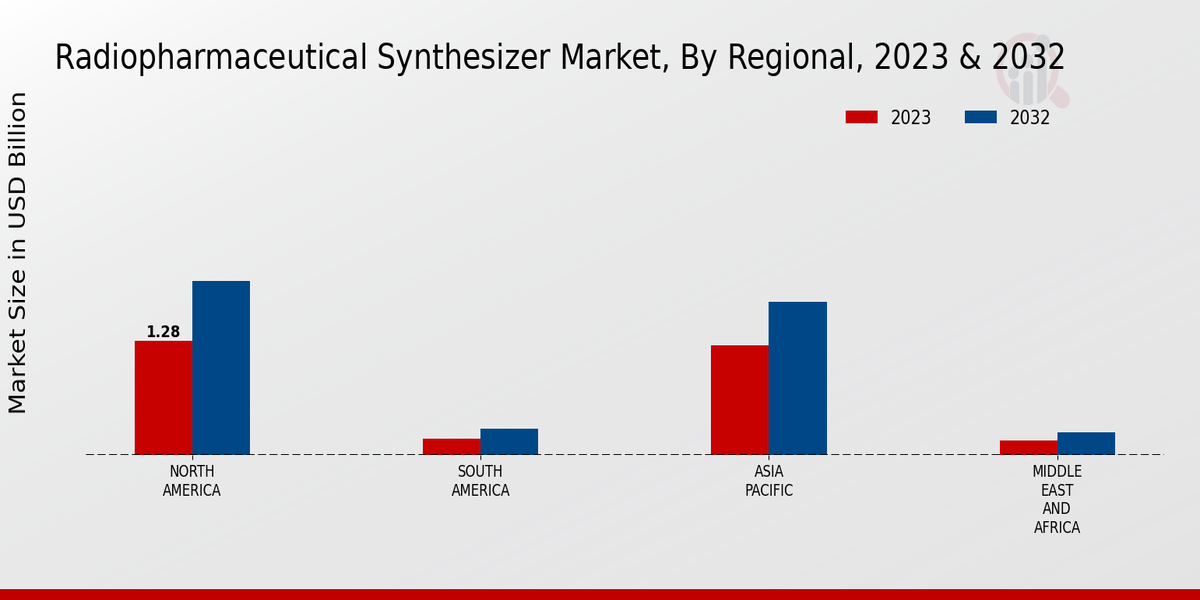Rising Incidence of Chronic Diseases
The Global Radiopharmaceutical Synthesizer Market Industry is significantly influenced by the rising incidence of chronic diseases, including cancer and cardiovascular disorders. As these conditions become more prevalent, the demand for effective diagnostic and therapeutic solutions escalates. Radiopharmaceuticals play a crucial role in the diagnosis and treatment of such diseases, leading to an increased reliance on synthesizers for their production. This trend is anticipated to sustain a compound annual growth rate (CAGR) of 4.41% from 2025 to 2035, reflecting the market's potential to address the growing healthcare challenges associated with chronic disease management.
Increasing Demand for Diagnostic Imaging
The Global Radiopharmaceutical Synthesizer Market Industry is experiencing heightened demand for diagnostic imaging techniques, particularly in oncology and cardiology. As healthcare providers increasingly rely on advanced imaging modalities, the need for radiopharmaceuticals has surged. For instance, the market is projected to reach 3.11 USD Billion in 2024, reflecting a growing emphasis on early disease detection and personalized medicine. This trend is likely to drive the adoption of radiopharmaceutical synthesizers, which facilitate the production of these essential compounds, thereby enhancing diagnostic accuracy and patient outcomes.
Expansion of Nuclear Medicine Applications
The expansion of nuclear medicine applications is a key driver for the Global Radiopharmaceutical Synthesizer Market Industry. With the increasing recognition of the benefits of radiopharmaceuticals in both diagnostics and therapeutics, there is a growing interest in their application across various medical fields. This includes not only oncology but also neurology and infectious diseases. As healthcare providers explore new therapeutic avenues, the demand for radiopharmaceutical synthesizers is likely to rise, facilitating the production of a broader range of radiopharmaceuticals tailored to diverse clinical needs.
Technological Advancements in Radiopharmaceuticals
Technological innovations are significantly shaping the Global Radiopharmaceutical Synthesizer Market Industry. Advances in synthesizer technology, such as automated synthesis and improved quality control measures, enhance the efficiency and reliability of radiopharmaceutical production. These innovations not only streamline workflows but also ensure compliance with stringent regulatory standards. As a result, healthcare facilities are increasingly investing in state-of-the-art synthesizers to meet the growing demand for high-quality radiopharmaceuticals. This trend is expected to contribute to the market's growth, with projections indicating a rise to 5.0 USD Billion by 2035.
Regulatory Support for Radiopharmaceutical Development
Regulatory bodies are increasingly supportive of the development and approval processes for radiopharmaceuticals, positively impacting the Global Radiopharmaceutical Synthesizer Market Industry. Initiatives aimed at expediting the approval of innovative radiopharmaceuticals encourage investment in synthesizer technology. This regulatory environment fosters collaboration between manufacturers and healthcare providers, ultimately enhancing the availability of radiopharmaceuticals. As a result, the market is poised for growth, with projections indicating a potential increase to 5.0 USD Billion by 2035, driven by the favorable regulatory landscape.

















